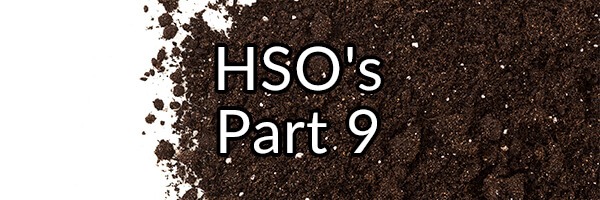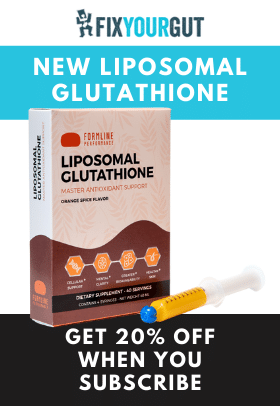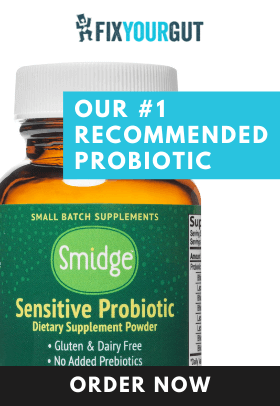Kiran seems to be at it again with a “re-branding” of MegaSporeBiotic known as Just Thrive. Just Thrive is very slick in its presentation and is available for sale on the retail market.
Is there much difference between MegaSporeBiotic and Just Thrive? Do I recommend Just Thrive over Megasporebiotic, even if I consider it to be the lite version? Are there any more studies to shed light on why I do not recommend most HSO probiotics?
Just Thrive = MegaSporeBiotic Lite
Imagine my surprise when I was shopping in my local grocery store, and I came across Just Thrive being sold in stores, and yes, I do check the digestive product and supplement aisles in pharmacies from time to time, I want to see what is being offered. Wow, an HSO probiotic being sold in stores. I wonder why the labeling including the listed strains looks so similar to MegaSporeBiotic. I go home and do my research. Just Thrive is rebranded MegaSporeBiotic, weird, it is, however, missing one particular strain, one Bacillus licheniformis. I criticized MegaSporeBiotic for its use of this opportunistic bacteria, interesting; they do not trust its safety to be sold in their retail version. Instead, they use the strain in MegaSporeBiotic only; that has to be sold by a licensed healthcare practitioner, so that they claim they can maintain some ethical reporting system, in case people are having issues with the probiotic. I guess I am the conspiracy theorist in my belief that Bacillus licheniformis is opportunistic and can cause problems, then again they do not trust it enough to put it in their retail version.
Megasporebiotic contains one more billion colony forming units (four billion) per capsule compared to Just Thrive which contains three billion colony forming units per capsule. My guess is the only difference between the two is that Just Thrive is missing one billion of Bacillus licheniformis.
Now, in Just Thrive’s defense, I would recommend it over MegaSporeBiotic because it lacks Bacillus licheniformis. That being said it would be the same if you ethylene glycol (antifreeze) or propylene glycol (Miralax), Miralax may be safer, but both are bad for your health.
Wait, there is more, there is a study that just came out that tests the virulence of the Bacillus genus and some of the strains in most HSO probiotics including MegaSporeBiotic and Just Thrive may contain some of these strains and my work is even more validated, tell me more!
HSO Probiotics From The Bacillus Genus, Not As Safe As Everyone Claims
Mostly everyone in the health blogosphere talks about how safe HSO “probiotics” are. There were limited studies into the pathogenicity of the most popular Bacillus strains that are used in HSO “probiotics.” A recent study was published that looked more into the pathogenic potential of the Bacillus genus. B. subtilis (Just Thrive, MegaSporeBiotic), B. licheniformis (MegaSporeBiotic), and B. pumilus (Prescript Assist) are common HSO “probiotics” found in supplements.
My first point that we are going to discuss is in relation to the Bacillus strains pathogenic potential and their frequency to be colonized within deep and superficial body sites. B. subtilis was found quite frequently on superficial sites (epidermis) which makes since it is a spore and depending on where you live, you would be exposed to it (increased chance if you live in a more rural area). It was the second most frequent cultured Bacillus (24%) next to the pathogenic B. cereus, a bacteria that is known to cause food poisoning. It was however found in deep sites as well (10%), where it could cause issues with infection if the area were compromised. B. licheniformis was found only in deep sites (10%) and not superficially, which makes since it is known to cause sepsis. Now granted, fewer bacteria are found in deep sites, but it is alarming that B. subtilis and B. licheniformis are more prevalent there. B. pumilus was found in both deep body sites (22%) and superficial body sites (12%). The study showed great concern about the pathogenic potential of B. pumilus, “B. pumilus was also frequently isolated, particularly from sterile body sites. Although known for its plant growth promoting activity, reports of infections due to B. pumilus are becoming more frequent in the literature“. Finally, B. licheniformis is resistant to penicillin.1
My second point is Bacillus bacterial virulence genes and potentiality. B. licheniformis, B. pumilus, and B. subtilis produce proteases. Bacterial proteases generated during overgrowth become exotoxins which increase inflammation and may harm probiotic flora. B. pumilus is also able to produce hemolysin, which are proteins that can destroy red blood cells and obtain heme iron for growth. Some strains of B. subtilis and B. pumilus contain NheA virulence genes. NheA is a non-hemolytic enterotoxin that has been linked to B. cereus ability to cause food poisoning.B. pumilus contains other virulence genes including the production of more non-hemolytic enterotoxins (NheB and NheC).2 3 4
Other virulence factors include bacteria’s ability to swim and or swarm. Bacteria that have flagella (tiny, whip-like appendages) can “swim” or propel themselves quickly, instead of being stationary and require outside factors to move. Having flagella makes it easier for bacteria to concentrate in different areas in the body. In itself, bacteria having flagella and being able to “swim” is not a bad thing, but when they become opportunistic, they can form “swarming” formations, akin to disturbing a beehive. Swarming increases pathogenesis, allowing bacteria to move to areas of overgrowth quickly, reduce the immune system’s ability to fight the swarm of bacteria (reduce engulfment by macrophages), increased toxin secretion, and antibiotic and antimicrobial resistance is increased during swarming. Most strains of B. licheniformis, B. pumilus, and B. subtilis can swim and swarm.5
My third point is the potential for Bacillus strains to form biofilms. Both probiotic and opportunistic bacteria produce biofilm, biofilm itself is not dangerous. Probiotic bacteria that produce biofilm, for example, can protect them from opportunistic bacteria that we come into contact. Opportunistic bacteria can also use biofilm to protect itself from our immune system and antimicrobial agents. Bacteria under biofilm are motionless for the most part; it is considered the antithesis to swimming and swarming. All strains tested in the study of B. licheniformis, B. pumilus, and B. subtilis were able to produce biofilm.6
My final point is that multiple studies have found that Bacillus licheniformis and subtilis may produce histamine. I have coached many clients who developed or worsened histamine intolerance and mast cell activation disorder from taking probiotics containing these strains. If you develop multiple symptoms, including itching, hives, diarrhea, insomnia, anxiety, racing thoughts, asthma, post nasal drip, and rarely anaphylaxis while taking a probiotic that contains these strains, contact me for coaching, and I will hopefully be able to help you find relief.
Now it is unknown that the particular strains of Prescript Assist, Just Thrive, or Megasporebiotic would have these virulence factors. To my knowledge, none of the companies have released data on their specific strains. Also, with many probiotic supplements, contamination of different strains occurs. More studies need to be performed to determine if HSO strains are as non-toxic and safe as everyone claims them to be, but so far the data that we have is not okay. Any probiotic can cause overgrowth or infection; Lactobacillus has been implicated in both, but for most, it is less virulent and easier to reduce to normal flora.







Please get your priorities in order. Promote SMIDGE probiotic(s). I will conclude this message
to you. You are pretty slick also.
David H.Keyishian,Rph.D.
No reply is needed due to the fact I do not need your comments or advice regarding any product
or supplements.
Thank you!
I take Ortho biotic from Orthomolecular a fine functional medicine company.I would like
you to evaluate each of the strains,species for me with your conclusion in detail.
Thank you.
David H.Keyishian,Rph.D.
Why are you listening to this guy? Who is he. Never heard of him. Probiotics changed my life. Is he a doctor? I haven’t a clue. I cannot find his background anywhere on this site, except he has been a health coach for 10 years. What is his education? How is he qualified to say what he is saying???
It’s easy to slander other manufacturers products just to promote your own or those you are affiliated with 👏🏻
All I know is that Megasporebiotics changed my life. I have suffered from extreme constipation for many many years. Tried EVERYTHING. Nothing worked. Megaspore worked almost immediately. Wonderful BM every morning. No diarrhea. 2 capsules everyday and years of misery gone. Gone. Of all my supplements, if I was told, “You can only take one,” I would choose Megasporebiotics hands down. Life changing!
I had severe rashes over a great part of my body. Three different series of corticosteroids and antibiotic treatments relieved the symptoms each time, but when I finished each treatment the rashes came back just as strong.
Then I viewed a presentation by Krishnan and purchased some megasporebiotics. Within three months the rashes completely disappeared and I have had no recurrence in 3 or 4 years. Needless to say, I maintain the use of the megasporebiotics. I have to assume the rashes occurred because of a leaky gut?
Barry
I have started megaspore , feel very ill and told to reduce my dose. symptoms, blurred vision, odema in ankles, knees, abdomen, blood pressure systolic dropped to 52. find it very concerning ,they have SUCH GREAT REVIEWS. Not sure what to do.
I have started megaspore half dose of ad minor head buzzing and feeling a bit flighty, then o started one capsule daily then on fourth day had anxiety restlessness dry mouth palpations so i took activated charcoal and symptoms subsided so I’m guessing it was just die off from an overgrowth as I had a fair bit of upper GI symptoms and constipation that had happened recently, so how was your outcome did you continue with the probiotics
Which brand please? I have rashes as well and for some relief.
FYI: Megaspore contains 4 Billion CFU per two capsules, not one. Not sure if the formula has changed since you posted this.
Taking Just Thrive was a game changer for me. I had been coming down w/little I’ll eases frequently and generally felt sickly. I felt so much better just a few weeks in from taking Just Thrive. That was 2 years ago and I’ve been taking it daily since then.
I have purchased Just Thrive and have not taken any, as of yet…but in reading the article I am not so sure that I should do so…very confusing on which ones will be beneficial versus harmful in the end.
I am so confused. Health care providers have been recommending spore based probiotics for me and my child. We both have been taking Just Thrive. I don’t want to buy anything harmful, of course, but I also want to heal our guts. Have your recommendations changed at all since 2017, John Brisson?
No they have not changed.
Thank you. Sadly, I now have no clue what to take. Also, I am going to need to take antibiotics for an infection soon. How will I get my gut fixed after that? Are there probiotics that are safe and effective? Should I avoid spore based probiotics completely?
I gave them to me and my son and they were amazing for us helped me with my allergies, my skin and stopped me from eating so much sugar
What is “them”, please?
Seems John Brisson is okay telling people what products he doesn’t want them to use, but isn’t so quick to advise what to use instead. Reading what others have commented in this thread, I see a lot of satisfied users of Just Thrive and MicrobiomeLabs products. I’d just try those products and see if it works. It probably will. If not, you can stop using them
Why are you listening to this guy? Who is he. Never heard of him. Probiotics changed my life. Is he a doctor? I haven’t a clue.
Bacillus HU36®, being a spore, offers advantages of better colonization and survival through the digestive track when compared to non-spore probiotic organisms; it also offers claims related to the most bioavailable form of antioxidants and carotenoids.
More details:
https://www.synergialifesciences.com/bacillus-indicus-strain-spore-probiotic-HU36.html
How do you know if/when you have normal flora?
Secondly, and related, how do you know if you have an overgrowth or infection caused from a probiotic (in my case it could very well be from Megasporebiotic)?
You can work with a Practitioner who uses stool test, like Diagnostic Solutions.
Yikes…thats scary…just watched some youtube videos about Microspore biotics and almost purchased a bottle…I guess i will stick to VSL#3…at least its safe to take….thank you for this article
Thorne Research sells B. Coagulans and I doubt they would sell something harmful. What is your opinion about this product and another one I have heard good things about called Lactospore?
Thanks
https://fixyourgut.com/hsos-part-8-why-i-am-on-the-fence-in-recommending-bacillus-coagulans/
Thank you, Steve, for your great recommendation!
John – Is it true that most probiotics are destroyed before entering the small intestine? I have personally tried several probiotics and sometimes they seem to help. Align used to help, but for some reason does nothing for me now? Most that I have tried do not work. NOW Brand used to make a Sacchormyces Boullardii Spore and that worked very good for me, but now they changed the formula and it doesn’t work at all.
I guess my question is this: Is it best to take or look for the “Spore” form of probiotic vs the most common forms?
I have tried some HSO’s and the two I tried did nothing for me… one was a Primal Defense and can’t recall the other one.
I was seriously considering about Thrive – but you kind of made me think twice about that – so for now it is No on that one.
Thanks
Some, yes, in addition it is even unknown if most probiotics implant or any positive or negative results are seen from ingesting dead organisms and the immune reactions that occur from this.
Common, I do not recommend spores, per this series of blog articles.
All the Japanese eating natto fermented by bacillus subtilis are in so much danger. We need to warn them. Those health benefits aren’t really health benefits. They need gutpro immediately…
Some people never read: https://fixyourgut.com/hso-probiotics-part-2-danger-supplementing-bacillus-subtilis/
I recently found this :
PRO-Moms does not contain any strains that are not resident to the human gut, like Soil Based Organisms (SBOs) or active yeasts.
Thank you for your information!! I appreciate it.
Take a read then. What do you think Accutane did to you?
You better believe all animals are constantly consuming soil based bacteria. Except humans as we have evolved, and getting sicker. They are finding heart disease is only 15 percent based on genetics.
https://www.stowers.org/media/news/aug-29-2016
SHIFTS IN THE MICROBIOME IMPACT TISSUE REPAIR AND REGENERATION
Researchers at the Stowers Institute have established a definitive link between the makeup of the microbiome, the host immune response, and an organism’s ability to heal itself.
On Bacillus subtilis, again sounds pretty dangerous. With references.
im not even going to get into everything they are finding out with mk7, which is what really could be dangerous, isolated from bacteria.
Health Benefits of B. subtilis
https://www.selfhacked.com/blog/b-subtilis/
(forget the website, the references are credible)
1) B. subtilis has Antioxidant Properties
2) B. subtilis May Be Beneficial in Obesity
3) B. subtilis May be Beneficial in Diabetes
4) B. subtilis is Beneficial for the GI Tract
B. subtilis Beneficially Modifies Gut Microbiota
B. subtilis Relieves Constipation
B. subtilis Ameliorates Diarrhea
B. subtilis May be Beneficial in IBS
B. subtilis is Beneficial in IBD
5) B. subtilis is Beneficial in H. pylori therapy
6) B. subtilis Boosts Immunity
7) B. subtilis Combats Infections
8) B. subtilis May be Beneficial in Liver Disorders
9) B. subtilis May Benefit the Skin
10) B. subtilis May be Beneficial for Dental Health
11) B. subtilis May Alleviates Heat Stress
12) B. subtilis May Combat Cancer
All animals are ingesting HSO’s to some degree including humans it is ubiquinous in nature. What happens to HSO’s when they enter the human gut, they pass right through, UNLESS you ingest large enough doses and they colonize the gut. So what happens when they colonize. For some as I have mentioned, might be beneficial you have seen many people that HSO probiotics helped. I on the other hand have seen the ones that it caused them issues, and it is way worse then any negative reaction I have ever seen from a Lacto or Bifido probiotic.
John, can you tell more about the negative effects you’ve seen, when and how they were eventually solved? Thanks a lot
I took a dive every time I introduced even the smallest amounts of megaspore, had to stop! Thanks for the perspective, and your legwork.
John, never have I seen someone so bleeding ignorant about a subject speak with such conviction and authority. It is quite clear that your agenda is to be the chicken little (or troll) of the interwebs on a subject you know very little about, in an effort to capture web traffic to hock your ebook. It would be lovely to see you openly debate someone who actually knows this stuff, so they can shred your infantile understanding of the microbiome and make you look like the fool you are.
Ok, so would you mind setting one up for me?
Fantastic series John. I have also been on the fence and curious about the efficacy and research behind the HSO’s. Although I have used them and seen people have positive effects (they did not work for myself however). I will reconsider my prescribing after reading this. I appreaciate your skepticism and pulling the research together to form an educated rebuttal to the various claims around HSO’s. Much appreciated.
I took it 3 times and have a fever and feel brain fog.
What do I do now?
Hi john, i’m from Israel. (sorry about my english)
I just bought a bottle of megaspore biotic and started using it by taking
only 3 capluses. Then i encounter your web site and i decided to stop taking it immediately.
Could it cause me any harm by using only 3 capsules or my colon can get rid of it by itself with no harm.
Thanks for a great article and follow up. Kiran sounds impressive (having seen some of his videos) and it would be easy for the lay person to be swayed by his comments. Thank you for taking the time and effort to look into this and present a few facts and alternate views!
Gutpro did ABSOLUTELY NOTHING for me. My ND distributes a few different probiotics; one of them being Megaspore biotic. Megaspore is the only one I have tried that I can feel has made a difference. Prescript Assist was garbage, Custom Probiotics did not make any difference, nor did Klaire labs therbiotic.
and by the way…garden of life’s “change of heart” to remove b. licheniformis is the reason it isn’t as effective now as when it healed me in 2005.
all this slander against products that actually help people. you sound so biased. to read your crap, the one-sided view, that you can’t think outside of the box is pathetic. as a writer, any reader would be immediately turned off by your ignorance. all you have to do is read the reviews of SBO products on amazon or iherb to know they work and they work safely.
FYI, Gutpro doesn’t look all that special. wish it were sold on a large platform like amazon so i could check out the reviews.
bottomline, you obviously have a personal agenda and it is not to help the masses. typically people in the naturopathic world are kind and understanding. you just sound like an ass. would be funny if not so sad.
history and the present has proved you wrong and the future will continue to do so.
There’s some serious projection in your comment, Greg. You are writing with the exact tone you accuse John of. Reading widely and exploring many people’s research is what helps me to make informed decisions. As John acknowledges many times in his articles, HSOs do work for some people, but because they do not work for ALL people, he doesn’t recommend them. Additionally because he cannot find adequate safety literature; which is different to research literature. John had his reasons and is simply sharing his views/research/knowledge, which is generous of him as we all benefit. Other research I have conducted allows me to understand that the more damaged the gut, the more sensitive people are to even beneficial supplements; and this explains why HSOs may more for some but not others. I have purchased some that I plan to take for myself, as they promote dopamine, and I know I am low due to years of stress, however my digestion is fairly good, so I feel confident it will provide me benefits. My son, however, whose dopaminergic pathways are on overdrive (noradrenaline huge pupils tell the tale!) will probably not benefit from them until his digestive issues are resolved such that his adrenals are restored to normal. Do you see how each person is different?? Those same reviews that speak of great results also have reviewers that speak of distress from taking HSOs. It is wise for John to be cautious and even wiser for each of us to take command of our health by researching far and wide, taking into consideration all opinions, so we can make informed decisions based on our own presentations and symptoms.
I took them for a couple of weeks and they gave me bad constipation, so no… not great for everybody. I have a relatively healthy gut, I thought a probiotic would help me with better nutrient absorption and keep all systems strong.
So I shouldn’t open the bottle of Just Thrive I ordered having watched Krishnan’s talk on probiotics and that is sitting in my cupboard waiting till I’ve finished my present round of Atrantil this week?
I would ask your healthcare professional, but I do not recommend its use.
Ona can you share your experience with antrantil?
What probiotic do you recommend if any? Thanks.
https://fixyourgut.com/gutpro-recomended-probiotic/